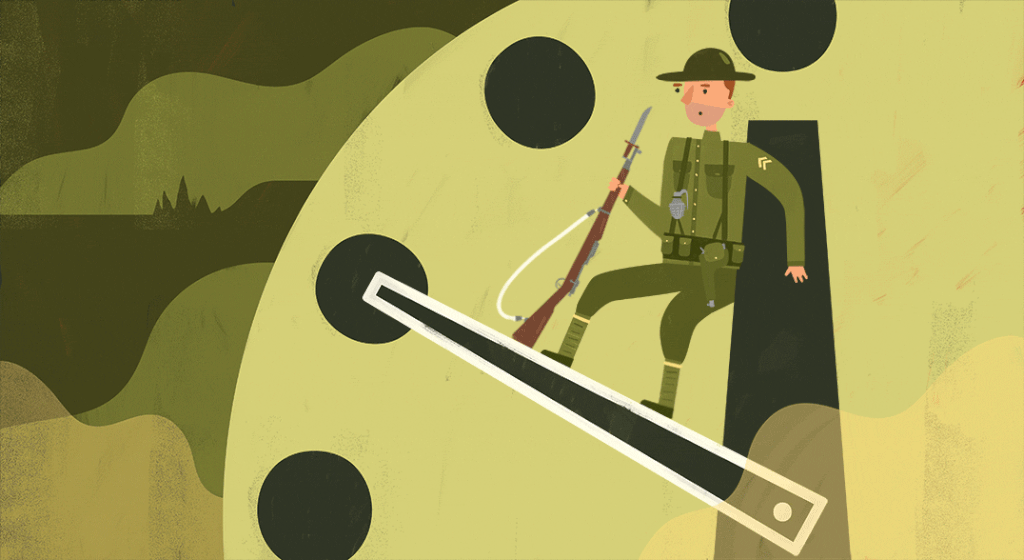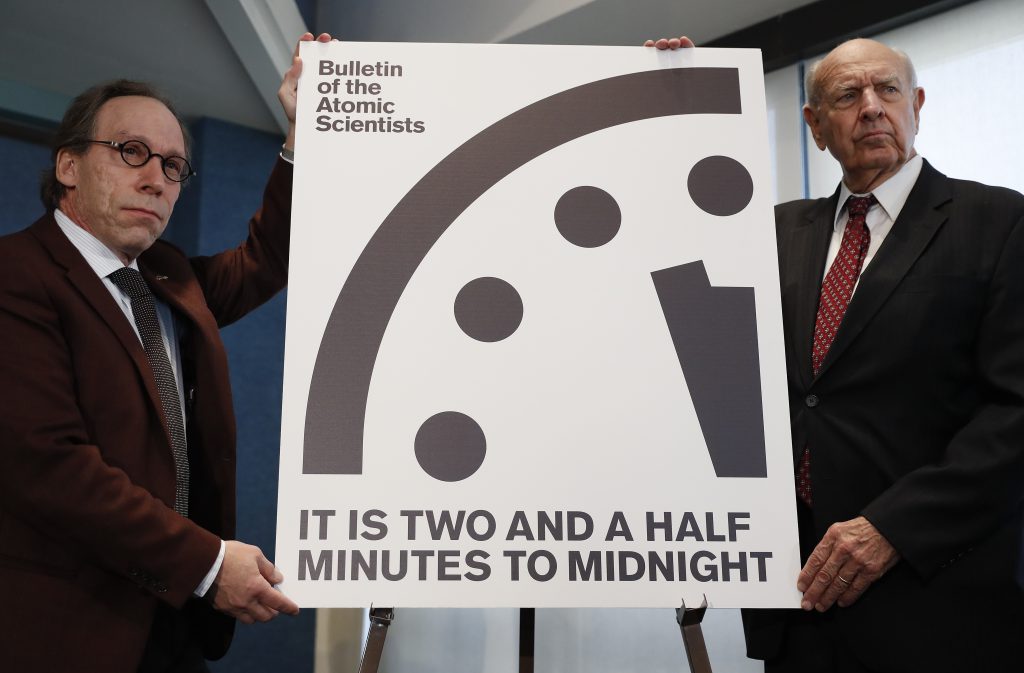Is the Clock Ticking Toward Doomsday?

Each January, the science and security board of the Bulletin of the Atomic Scientists unveils an estimate of the likelihood that humanity will self-destruct. They do so by marking the time on a metaphorical “Doomsday Clock,” on which midnight represents the apocalypse. In 2017, the clock stood at a frightening two and a half minutes to midnight; this month could easily see the minute hand creep even closer to doom. Is panic warranted? And if so, can we unpack how and why humanity seems destined to cause its own annihilation?
At its start in 1947, the Doomsday Clock was set at seven minutes to midnight. Since then, its minute hand has ticked as far forward as two minutes to midnight in 1953—in the wake of hydrogen bomb tests by both the United States and Soviet Union—and as far back as 17 minutes to the hour at the end of the Cold War in 1991. In January 2017, the Bulletin moved the clock forward by just 30 seconds—from three minutes, where it had rested for two years, to two and a half minutes to midnight. They made this unprecedented move of only a fraction of a minute, they explained, because “as this statement is issued, Donald Trump has been the U.S. President only a matter of days.”
The board consulted with a group of sponsors, 15 of whom are Nobel laureates, before resetting the clock in 2017—but not everybody agreed with the Bulletin’s gloomy outlook. Less than four months after the clock’s readjustment, Microsoft co-founder Bill Gates tweeted to recent college graduates that “this is the most peaceful time in human history,” citing psychologist Steven Pinker’s 2011 book The Better Angels of Our Nature: Why Violence Has Declined as his source. Unsurprisingly, after Gates’ tweet, Pinker’s book zoomed to the top of Amazon’s best-seller list.
My colleague Charles Hildebolt and I wanted to understand how and why people have come to such fundamentally different conclusions. We began by reading Pinker’s book. As evolutionary anthropologists, we were particularly interested in his claim that our hunter-gatherer ancestors “started off nasty and … the artifices of civilization have moved us in a noble direction.” More specifically, Pinker argued that people who live in states (roughly defined as “so-called civilized societies”) are relatively peaceful compared to people from smaller, more traditional societies, like the communities from New Guinea that cultural anthropologist Margaret Mead famously studied. This, Pinker said, is because residents of states are more influenced by the “better angels” of reason, morality, empathy, and self-control.
The main evidence Pinker offered was a bar chart showing that larger percentages of the populations died annually from warfare in nonstate than state societies. It makes a certain sense to look at this ratio because it reflects a person’s chance of being a victim of warfare. But looking at this ratio on its own is foolish, as it ignores impacts from the actual size of the population. We knew from our previous research in biological anthropology that you must look at both ratios and absolute numbers.
Consider this well-known example from biology: People’s heads are usually a certain percentage of their body size. If that ratio is unusually big or small, it might be a sign of disease. But you also need to take a person’s age into account, because it is normal for babies to have relatively large heads compared to their bodies. A head that would look grotesquely huge on a high school student would be typical for a much smaller-bodied occupant of a nursery school. You need to look at both the ratio of head size and the actual body size to get a full picture.
Because Hildebolt and I love nothing better than graphs and numbers, we decided to get to the bottom of Pinker’s chart to see if the nonstate societies he used as proxies for early human ancestors really were more violent than modern “civilized” folk. For starters, we collected details about war deaths in the nonstates that Pinker studied, plus a few others. We also examined battle deaths in 11 communities of chimpanzees (one of our closest evolutionary “cousins”), 19 countries (“states”) that participated in World War I, and 22 countries that fought in World War II.
Pinker was right about nonstate societies usually losing greater chunks of their populations to warfare in comparison to states. However, to our surprise, we found that the percentages of war deaths were best predicted not by state- or nonstate-hood but by population size, for both chimpanzees and humans. In a New Guinea clan cluster of 300 people in 1955, for example, nearly 8 percent died yearly from warfare, whereas in an 1860s nonstate chiefdom of 200,000 people in Fiji, less than 1 percent died annually from warfare. These are just isolated examples, of course, and there are some exceptions to the rule; human history is messy and the trend isn’t always obvious when you compare just a few societies. But on the whole, statistically, no matter what type of society (state or nonstate), historical records indicate a striking trend for smaller populations to have larger percentages of their inhabitants die in war.
Moreover, the number of people in a given society who died during conflict doesn’t tell you about how violent those people were but rather how vulnerable they were; after all, we don’t know anything about how much killing a given society did, only how much they suffered from killing.
Together, these facts lead to an intuitive conclusion: For chimpanzees and people living in all types of societies, there is safety in numbers. This is why primatologists quip that “a lone baboon is a dead baboon” and why people are wise to avoid walking alone down a dark alley at night. Pinker concluded that nonstate societies were more violent. But we have a different interpretation: They were more vulnerable to violence because they were small.
Despite their similarities, warfare in chimpanzees and humans differs in an important way that may have implications for the doomsday scenario. For people, as population size goes up, the total number of annual war deaths goes up—even as the percentage of war deaths goes down. But this trend toward bigger losses in bigger societies does not exist in chimpanzees.
We think there are sociocultural reasons for this: Larger societies garner critical masses of experts who advance weapons technology and military strategies, for example, accounting for larger losses in the most extreme kinds of war. This kind of scaling happens in other social trends too: Bigger societies get more bang for their buck in the number of inventors they produce and patents they file, for instance. These increasing “returns” just don’t happen for chimps.
Given all this, the current global population trends aren’t encouraging. Countries and cities are getting bigger, which should, theoretically, lead to larger overall war losses (even if the percentages are smaller). But even more worrisome is the fact that population growth is soaring, particularly in areas with historically unstable politics. Given the math—and the daily news about the tense relationship between the U.S. and North Korea (as just one example), along with the unfettered combativeness of Trump and Kim Jong-un—a third World War seems plausible. Hildebolt and I will not be surprised if this month the Doomsday Clock is set at least one minute closer to midnight than it now stands—and thus, closer to the extinction of Homo sapiens than it has ever been.
Of course, the solutions for world peace are complicated. The statistics tell us that we should stop national populations from booming and prevent a growing mass of intelligent people from inventing new things like ever-more-deadly weapons. Neither seems particularly realistic. But one thing we can do is stop characterizing people who recently lived in small hunting and gathering groups as inherently more violent than those from state societies. The historic data show that members of nonstates were more vulnerable because they lived in small populations—not more violent because they were lacking in “better angels,” such as reason and moral sense.
In these troubled times, it is unwise to propagate the feel-good message that, when it comes to warfare and our species’ ultimate survival, humans are doing just fine. The Doomsday Clock, as depressing as it may be, keeps on ticking.


































